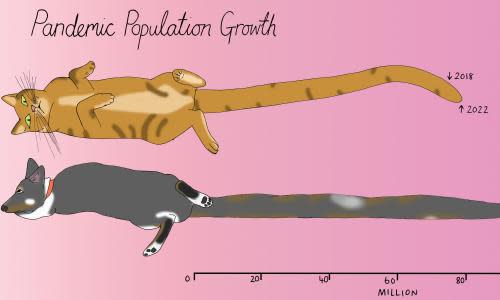Pets prove to be the pandemic’s cute, furry growth area

Her name was Peanut. I was drawn to her because she looked like the Jack Russell terrier from the TV show Frasier (the only likable member of the cast) and maybe also because of some bottomless loneliness. The pandemic seemed to nudge so many people into getting pets so maybe I should also become a mother to this oversized rat?
Related: Tim Scott says ‘America is not a racist country’ – the data says otherwise | Mona Chalabi
A lot of people in the US got a dog in the pandemic. Almost 9 million dogs have been acquired by households since the start of the pandemic (a number equivalent to the population of New York City) bringing the total number of dogs in the US to 108 million (that’s roughly one dog to every three humans in the US). And cats crept up too – an additional 5 million in the space of just a few years bringing the total US feline count to 79 million.
It’s hard to say how many of these pets have gone to first-time owners. In fact, all of these numbers are pretty rough estimates because counting animals is a lot less rigorous than counting humans. But several organizations are interested in getting this data – whether it’s veterinary groups or pet food manufacturers – pet ownership has big consequences for household spending and the US economy in general. The numbers I’m using here come from the American Pet Products Association.
There were concerns among animal rights groups that many of these animals went to first-time owners who weren’t necessarily well-equipped to take good care of them. People who kept jobs might need to return to their place of work and abandon their pets. And those who had lost their jobs (a lot of people in the US have) might not be able to afford their new animals either. Some sources, like this study in the journal Frontiers in Veterinary Science, have even disputed these numbers and found a small decline in pet ownership, which was attributed to pet owners decreasing financial security.
The authors of the study were especially interested in retention – in other words, how many of the households that got new pets during the pandemic have kept them? But it turns out that most of the dogs and cats who found new homes during the pandemic are still there. Reassuringly, national databases of animal shelters didn’t see a big spike in animals being “surrendered”. Overall, 90% of the dogs and 85% of the cats that were acquired during Covid, are still in their new homes.
I feared I would be part of the 10% so I never took Peanut home from the shelter after I met her last year. But if I had, I think I would have changed her name – anything but Bella or Max, since it turns out those are the canine equivalent of calling a child John Smith.

 Yahoo News
Yahoo News 